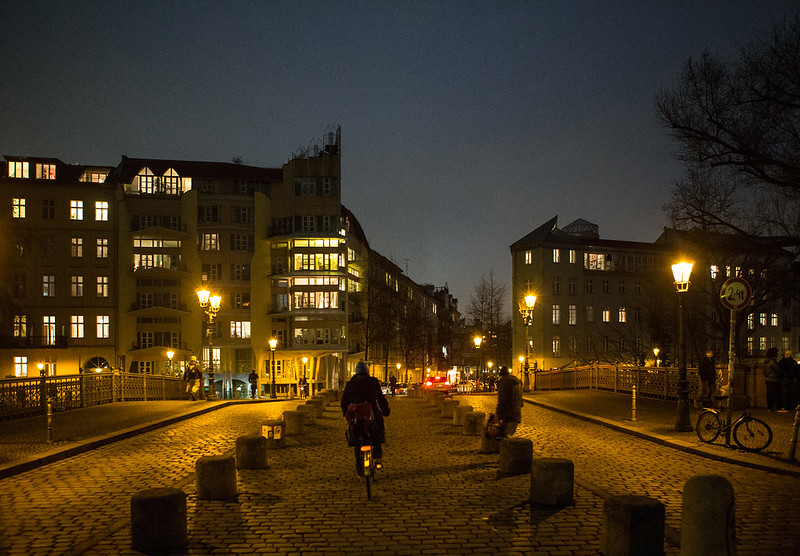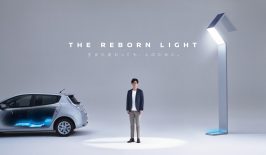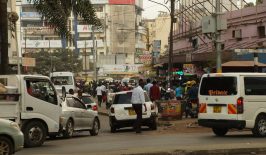The German capital’s utopian-sounding “Radbahn” is one step closer to becoming reality, following promises by the government to commit funds to the ambitious, and long-anticipated, bicycle path project.
Last time we spoke to the co-founders of Berlin’s “Radbahn” project (in an interview just after the project’s conception back in 2015) it was still far more of a utopian-sounding concept than reality. But even back then, they had big plans: to transform the space underneath one of the Berlin metro’s more distinctive lines – the elevated U1 – into an partly-covered, protected, 8.9km bicycle lane complete with service stations, greenery and even solar panels.
The tracks of the U1 currently skim over the heads of Berliners in Warschauer Straße in the East, passing through Kreuzberg and the heart of the city, before dipping underground and continuing all the way to Uhlandstraße in the West. Underneath the metro’s elevated tracks in the East lies a mostly vacant stretch of concrete, nothing more than a desolate pathway nestled between car lanes on each side.
The team behind Radbahn want to reclaim and revive that largely unused concrete space by turning it into a “green artery” that would allow cycle traffic to flow more freely through the heart of Berlin – and offer cyclists a safe trip along, and under, Berlin’s first rail line, between “Zoo” in the West and “Oberbaumbrücke” in the East. Conceived in 2015, the ambitious project has now received financial backing from the German government and the city of Berlin, and a trial section is set to become reality – uniting community values with urban innovation and sustainable mobility. We caught up with Perttu Ratilainen from Radbahn and Paper Planes e.V. to hear about the progress of the project, the impact it could have on the local community, and the importance of collaboration when it comes to turning your dream into reality.
Can you give us an update on the project? What’s the latest news?
There are two key developments: first, the Senate of Berlin announced a technical feasibility study for a 200 metre section of the project (from Schlesisches Tor to Kottbusser Tor). That study is expected to take around a year and in theory this section of the project could start being realised after that. Using some of the funding we received from the city and from the German Interior Ministry we’ll also do our own study as part of a three-pronged sub-project called “Reallabor Radbahn” – which will provide a venue for events on collaborative urban design and mobility.
Then as of July we finally have the means to get our own office and expand our team. Previously our time and finances have been limited; now we can reach out more and increase the project’s visibility. We’re keen to work with all kinds of stakeholders, but also with local communities, academics, cyclists, and of course, artists and cultural actors.
You predicted one of your biggest challenges would be conservative attitudes to cycling infrastructure. How have you overcome that?
Actually I’d say the main issue was lack of money for cycling infrastructure, which the city now has ten times more of. But yes, we also had to deal with lack of cohesive support from different stakeholders. Although it might seem simple, Radbahn is actually a complicated project because it involves more than one department and numerous districts, and cross-sectional projects have always been difficult in Berlin. But as far as I know there’s no longer anyone who doesn’t like the project! Now we’re in a better position – we have a diverse, supportive stakeholder network including associations, businesses and politicians.
Could you talk a bit about the role of people’s support for the project?
We’ve received phenomenal support from people around the world, including the crowdfunding which enabled us to continue, and the encouragement from people spreading the news. Maybe most importantly though, we got so much pro bono help from people of different backgrounds: the writers who contributed to our book, the woman who took a week’s unpaid vacation to translate the book into English, the person who built our competition website… Their professionalism and belief in the project is what has got us this far.
What has been the most surprising aspect of the project for you?
Personally I was amazed by all those who jumped in with massive contributions of work, and the eagerness of the Berlin community to help projects that they somehow feel connected to.
What’s the one piece of advice you’d give to someone wanting to set up their own infrastructural ecoproject?
Start looking for support from different areas. Sometimes people working in sustainability ignore players in society who could actually provide crucial assistance. Even if you don’t want to work with corporations there’s no reason to piss them off, either. In our funding application we had letters of intent from stakeholders like the Berlin Artist Association, Factory Berlin and big corporations. So reach out and build your networks!
It can be hard to find investors for infrastructure and you need to show that you’re seriously committed, so you need a lot of endurance for that. Also, some people don’t share their ideas in case others steal them, but I’d say do the complete opposite; be open, get feedback, make people feel part of your dream and they will help you out.
Copenhagen and Amsterdam are way ahead of Berlin when it comes to biking infrastructure. What do you think the next step is for Berlin if they want to move in a similar direction?
Though it’ll take years for Berlin to catch up with Copenhagen and Amsterdam, it’s clear the city is doing quite a bit now – there are beautiful cycle paths popping up everywhere. This has to be combined with public transport and shared car services (ideally electric). There’s lots of interesting innovation happening in urban mobility. But Berlin should also definitely keep investing in bike infrastructure with an open-minded spirit and eagerness to learn… That’ll lead to something nice, I’m sure of that.
What do you think the social impact of the project could be?
Our big vision is to create a role model for other cities, not just in Berlin or Germany but globally. The aforementioned Reallabor showcase will provide a venue that brings together people from different walks of life. It’s important for city space to be a place where everyone can interact with each other. That’s what I feel is disappearing from urban living today. People get isolated from one another – they drive their cars but don’t communicate with neighbours, or understand who they share urban space with. It would be so beautiful to create something that nurtures the feeling of being in the city together.
For more information about Radbahn, visit the project’s official website.






